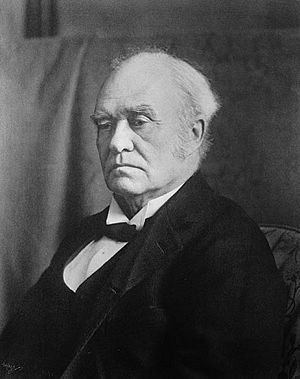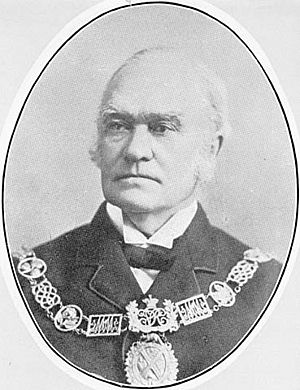John Abbott facts for kids
Quick facts for kids
Lieutenant-Colonel the Honourable
John Abbott
|
|
|---|---|

Abbott in 1892
|
|
| 3rd Prime Minister of Canada | |
| In office June 16, 1891 – November 24, 1892 |
|
| Monarch | Victoria |
| Governor General | Lord Stanley of Preston |
| Preceded by | John A. Macdonald |
| Succeeded by | John Thompson |
| 19th Mayor of Montreal | |
| In office 1887–1889 |
|
| Preceded by | Honoré Beaugrand |
| Succeeded by | Jacques Grenier |
| Canadian Senator from Quebec | |
| In office May 12, 1887 – October 30, 1893 |
|
| Appointed by | John A. Macdonald |
| Constituency | Inkerman |
| Member of Parliament for Argenteuil |
|
| In office 1880–1887 |
|
| Preceded by | Thomas Christie |
| Succeeded by | James Crocket Wilson |
| In office September 20, 1867 – 1874 |
|
| Preceded by | Riding established |
| Succeeded by | Lemuel Cushing, Jr. |
| Personal details | |
| Born |
John Joseph Caldwell Abbott
March 12, 1821 Saint-André, Lower Canada |
| Died | October 30, 1893 (aged 72) Montreal, Quebec, Canada |
| Resting place | Mount Royal Cemetery, Montreal |
| Political party | Conservative |
| Spouse |
Mary Bethune
(m. 1849) |
| Children | 8 |
| Parents | Joseph Abbott Harriet Bradford |
| Education | McGill University (1847) |
| Signature | |
| Military service | |
| Allegiance | Province of Canada Dominion of Canada |
| Branch/service | Canadian Militia |
| Years of service | 1866–1874 |
| Rank | Lieutenant-Colonel |
| Unit | 11th Argenteuil Battalion |
| Commands | Canada–United States border |
Sir John Joseph Caldwell Abbott (March 12, 1821 – October 30, 1893) was a Canadian lawyer and politician. He served as the third Prime Minister of Canada from 1891 to 1892. He was the leader of the Conservative Party during his time as prime minister.
Abbott was born in what is now Saint-André-d'Argenteuil, Quebec. He studied law at McGill University and became a well-known lawyer in Montreal. He later taught law at McGill. He was the first prime minister born in Canada.
He became prime minister in June 1891 after John A. Macdonald passed away. Abbott was 70 years old when he took office. He served for about 17 months before retiring in November 1892 due to poor health. He passed away the following year.
Contents
Early Life and Family
John Abbott was born in St. Andrews, Lower Canada (now Saint-André-d'Argenteuil, Quebec). His parents were Harriet (née Bradford) and Reverend Joseph Abbott. His father was an Anglican missionary from England.
In 1849, Abbott married Mary Martha Bethune. She was related to Dr. Norman Bethune. Mary's father was John Bethune, who was also an Anglican clergyman and acting president of McGill University.
John and Mary had eight children, four sons and four daughters. Many of their children did not have descendants. Abbott was also the great-grandfather of Canadian actor Christopher Plummer.
Military Service
Abbott was involved in the local militia from a young age. In 1849, he signed a document called the Montreal Annexation Manifesto. This document asked for Canada to join the United States. He later said he regretted this decision.
In 1861, he recruited 300 men to form the Argenteuil Rangers. This was during a time of tension with the United States called the Trent Affair. This action may have helped him make up for his earlier mistake.
He was promoted to Lieutenant-Colonel in the 11th Argenteuil Battalion. He served during the Fenian Raids, which were attacks by Irish-American groups. He retired from the militia in 1883.
Legal Career and Education
Abbott earned his Bachelor of Civil Law degree from McGill College (now McGill University) in Montreal in 1847. He later received a Doctor of Civil Law degree in 1867.
Most of his legal work was in corporate law, which deals with businesses. He also taught commercial and criminal law at McGill University starting in 1853. In 1855, he became a professor and dean of the Faculty of Law. One of his students was Wilfrid Laurier, who later became a prime minister of Canada. Abbott continued teaching until 1880.
His most famous court case involved defending Confederate agents. These agents had raided St. Albans, Vermont, from Canadian land during the American Civil War. Abbott successfully argued that they were soldiers, not criminals. This meant they should not be sent back to the United States.
After he retired from teaching, McGill University named him an emeritus professor. In 1881, he joined the university's Board of Governors.
Political Journey
Early Steps in Politics
In 1849, John Abbott signed the Montreal Annexation Manifesto. This document suggested that Canada should join the United States. He later said this was a mistake he made when he was young. He then joined the Loyal Orange Lodge, a group that supported Britain.
Abbott first ran for Canada's Legislative Assembly in 1857. He ran in the Argenteuil area, near Montreal. He lost that election. However, he challenged the results because of problems with the voting lists. He was eventually given the seat in 1860.
He served as solicitor general for Lower Canada (Quebec) from 1862 to 1863. He was part of the government led by John Sandfield Macdonald and Louis Sicotte.
Abbott was not fully in favour of Confederation at first. He worried that English-speaking people in Quebec would lose political power. In 1865, he became a Conservative. He suggested protecting the voting areas for 12 English Quebec constituencies. This idea was included in the British North America Act, 1867.
National Political Career
Abbott was elected to the House of Commons of Canada in 1867. He represented the Argenteuil area. He lost his seat in 1874 due to issues related to the Pacific Scandal. He lost the 1878 election by a small number of votes. He won in February 1880, but his victory was cancelled due to problems with the election. However, he was elected again in a special election in August 1881.
In 1887, John A. Macdonald appointed him to the Senate of Canada. He became the Leader of the Government in the Senate. He also served as a Minister without Portfolio in Macdonald's cabinet. This meant he was a minister without a specific department.
Abbott also served two one-year terms as mayor of Montreal from 1887 to 1889.
He was involved in building several railways, including the Canadian Pacific Railway (CPR). He helped set up and find money for the first CPR group. As a legal advisor, he received a famous telegram from Prime Minister Macdonald. This telegram was stolen from Abbott's office and published. This event led to the 1873 Pacific Scandal, which caused Macdonald's government to fall.
Abbott then helped organize a second group that finished building Canada's first transcontinental railway in 1885. He was a lawyer for the railway from 1880 to 1887. He was also a director from 1885 to 1891.
Becoming Prime Minister
When Prime Minister Macdonald passed away in office, Abbott supported John Thompson to take his place. However, the Conservative party was divided. They asked Abbott to lead the government. He agreed, even though he saw himself as a temporary prime minister.
He was one of only two Canadian Prime Ministers to hold the job while serving in the Senate. The other was Mackenzie Bowell.
Soon after Abbott became prime minister in 1891, Canada faced an economic slowdown. Later that year, he dealt with another challenge. This was the McGreevy-Langevin scandal. It showed that Hector-Louis Langevin, a former minister, had worked with a contractor to cheat the government.
Despite these challenges, Abbott worked through many government tasks. These included improving the civil service and updating the criminal code. In 1892, he tried to make a new trade agreement with the United States, but it did not work out.
During his time as prime minister, there were 52 special elections. The Conservatives won 42 of them. This increased their majority by 13 seats. This showed that Abbott was an effective leader.
Later Life and Legacy

Abbott's health declined in 1892. He was suffering from early stages of brain cancer. He retired from public life. Sir John Thompson then became Prime Minister. Abbott passed away less than a year later, at age 72.
Sir John Abbott is buried in the Mount Royal Cemetery in Montreal, Quebec.
John Abbott College in Sainte-Anne-de-Bellevue, Quebec, is named after him. This college is near his large country estate.
The Canadian government recognized him as a Person of National Historic Significance in 1938.
One of his most famous quotes is "I hate politics." He explained this by saying he disliked public meetings, speeches, and other parts of politics. However, he loved "doing public work to the best of my ability."
Historians have ranked Canadian prime ministers. In a 2016 survey, Abbott was ranked 7th out of ten prime ministers who served for a short time.
See also
 In Spanish: John Joseph Caldwell Abbott para niños
In Spanish: John Joseph Caldwell Abbott para niños
- List of Montreal mayors
- List of prime ministers of Canada
- List of notable Freemasons



